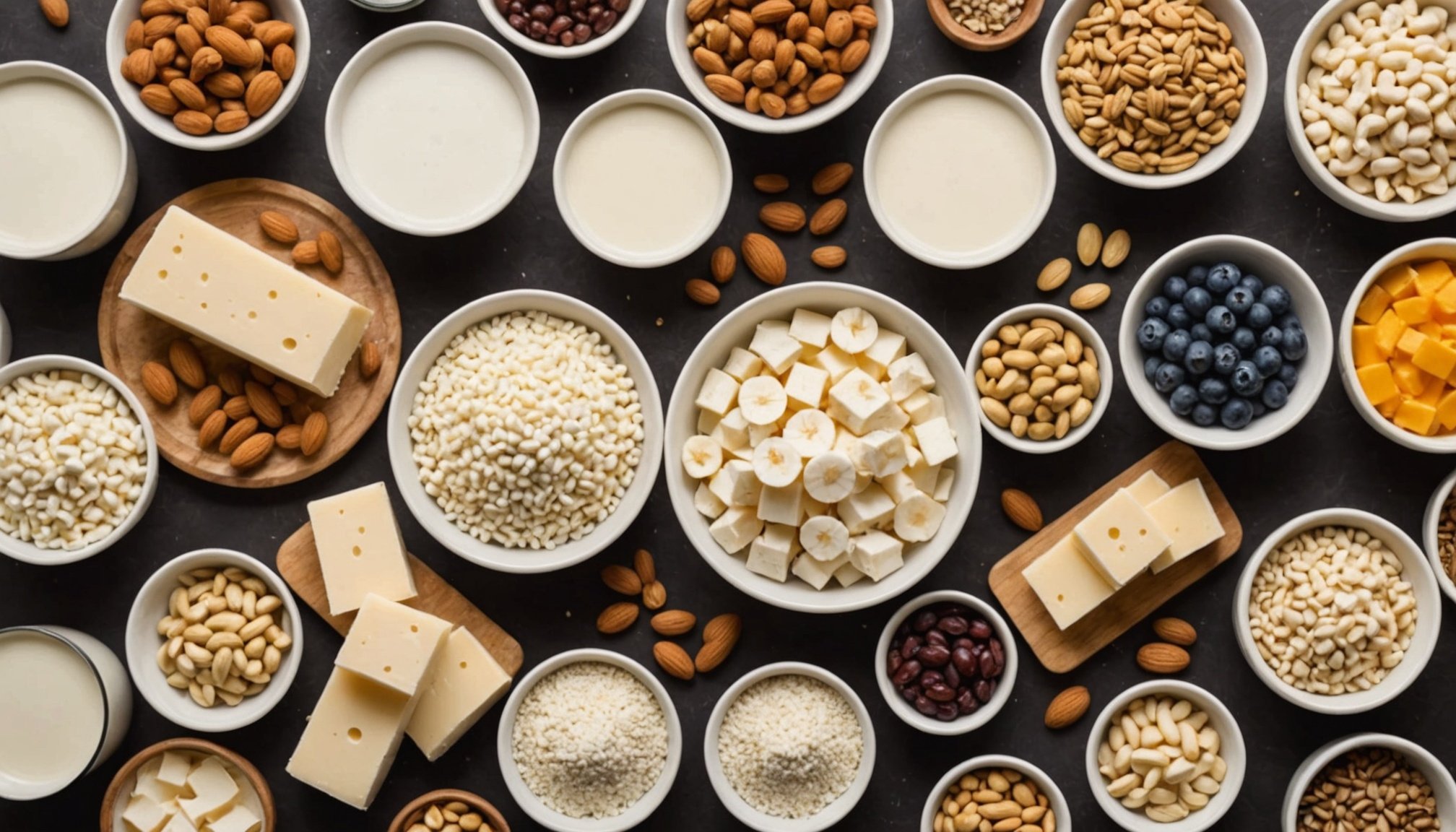Overview of Calcium Needs for Lactose-Intolerant Individuals
Understanding calcium needs is critical for maintaining strong bones and overall health, especially for those with lactose intolerance. This condition can complicate meeting daily calcium requirements due to the avoidance of dairy products. Calcium is essential for bone density, nerve function, and muscle contraction. For lactose-intolerant individuals, it’s important to find alternative sources to fulfill these dietary requirements.
The recommended daily intake of calcium varies by age and gender, but adults typically require around 700-1,000 mg per day. Lactose-intolerant individuals should focus on calcium requirements from non-dairy foods or fortified products to meet these needs effectively. Common misunderstandings persist, such as the belief that dairy is the only significant source of calcium. In reality, several non-dairy options, like fortified plant milks, leafy green vegetables, and nuts, are excellent choices for maintaining adequate levels.
In the same genre : Essential strategies for uk parents to cultivate healthy sleep habits in children
Being informed about these alternatives can help prevent deficiencies and support a healthy lifestyle, offering a practical solution to the dietary challenges presented by lactose intolerance. Adopting a varied diet can help ensure calcium needs are met.
Key Non-Dairy Sources of Calcium
For individuals seeking non-dairy calcium sources, it’s important to explore a variety of food alternatives. Plant-based options are especially significant for those with lactose intolerance.
Topic to read : Essential tips for uk adults to slash sugar intake: a practical guide to healthier living
Leafy Green Vegetables
Leafy greens like kale and bok choy are excellent choices for calcium content. These vegetables not only contribute to your daily calcium intake but also provide additional nutrients like vitamins K and C. Including such veggies in your meals can significantly improve your dietary calcium needs.
Nuts and Seeds
Almonds and chia seeds are potent in calcium and other essential nutrients. A handful of almonds offers a convenient snack while delivering ample amounts of healthy fats and protein. Meanwhile, chia seeds, often used in puddings and smoothies, add substance and nutrition to your diet.
Fortified Plant Milks
Fortified plant milks, such as almond, soy, or oat milk, often match the calcium level of regular milk. It’s crucial to check labels for calcium fortification to ensure you’re meeting your dietary requirements effectively. These milks can be easily integrated into daily routines, providing a lactose-free alternative that caters perfectly to lactose intolerance.
Nutritional Comparison of Non-Dairy Calcium Sources
In evaluating non-dairy foods for calcium content, it’s crucial to compare them with traditional dairy products. The calcium content in fortified plant milks, like almond or soy milk, often rivals that found in cow’s milk, providing a viable option for those with lactose intolerance. However, the bioavailability—or absorption efficiency—of calcium can vary across sources. Studies suggest that while certain non-dairy options, like leafy greens, offer high calcium levels, factors such as oxalates present in vegetables can affect absorption.
When considering alternative diets, it’s essential to ensure they’re nutritionally complete. Including a diverse range of calcium-rich foods can help meet dietary requirements, providing not just calcium but other essential nutrients. Foods like chia seeds and almonds also contribute to a balanced diet with their protein and healthy fat content.
Addressing the misconception that non-dairy sources are inferior, it’s important to highlight the broader nutritional profile and benefits they offer. By staying informed about calcium content and focusing on a varied diet, individuals can effectively manage their calcium intake and maintain overall health.
Recipes Featuring Calcium-Packed Non-Dairy Foods
Exploring non-dairy recipes is an enjoyable way to meet dietary requirements and embrace a healthy lifestyle. Let’s dive into some calcium-rich meals that excite the taste buds while catering to dietary needs.
Smoothies and Juices
Crafting smoothies with spinach and fortified plant milk is an excellent choice. Combine a handful of spinach, a banana, and a cup of fortified almond milk. For a bit of zing, add a splash of orange juice. This vibrant blend packs a nutritious punch, boosting your calcium needs seamlessly into your morning routine.
Salads and Bowls
Incorporate calcium-rich meals by creating salads with texture and flavour. Toss kale with quinoa, sprinkle with chia seeds, and dress with a lemon-tahini sauce. This mix ensures a wholesome meal, offering ample plant-based options for calcium content.
Snacks and Dips
Nut-based snacks like almond dips are simple and nutritious. Blend soaked almonds with garlic, lemon juice, and a little water. Use this creamy dip for veggies or whole-grain crackers. Enjoying these tasty bites helps maintain calcium needs while supporting a lactose intolerance friendly diet.
Tips for Managing Lactose Intolerance
Navigating lactose intolerance can be challenging, but with practical strategies, you can maintain a balanced diet and control symptoms effectively. Here are some tips to help transition smoothly into a non-dairy diet.
Begin by familiarising yourself with hidden sources of lactose in foods such as baked goods, certain sauces, and even some medications. Being proactive in reading labels and understanding ingredients offers more control over your dietary requirements.
To manage symptoms, try gradual dietary changes. Start by incorporating small amounts of lactose-free alternatives and non-dairy sources to build comfort with new food textures and flavours. Consistency is key to easing this transition.
For symptom relief, consider choosing lactase enzyme supplements to support digestion when accidental exposure to lactose occurs. These can be a valuable tool during social events or dining out, offering peace of mind and helping to prevent discomfort.
Lastly, seek support from individuals or groups going through similar experiences. Sharing recipes and advice on calcium needs can broaden your understanding and introduce new, enjoyable dietary habits to suit your lifestyle. This empathetic approach encourages a positive view of managing lactose intolerance.
Availability of Non-Dairy Calcium Sources in the UK
Navigating your way through UK food options for non-dairy calcium sources requires a bit of planning. Fortunately, there are abundant local availability and grocery shopping opportunities. Delving into these avenues can simplify meeting your dietary requirements sans dairy.
Supermarkets and Health Food Stores
Mainstream supermarkets like Tesco, Sainsbury’s, and Waitrose are increasingly stocking non-dairy choices. Look for fortified plant milks and leafy greens that enhance your calcium intake. Health food stores such as Holland & Barrett offer plant-based and specialty items to cater to lactose-intolerant individuals.
Online Shopping for Specialty Items
For convenience, explore online platforms catering to UK food options. Websites like Ocado deliver calcium-rich products directly to your door. This is particularly beneficial for hard-to-find or specialty items, ensuring you never miss out on essential nutrients.
Seasonal and Local Produce
Exploring local farmers’ markets introduces you to fresh produce rich in calcium, like bok choy and almonds. Seasonal offerings not only offer sustainability but also a delightful variety that encourages a diverse and balanced diet. When prioritising local availability, your grocery shopping stamps a smaller carbon footprint while maintaining your nutritional goals.
Common Concerns and Myths About Non-Dairy Calcium Sources
Navigating the landscape of non-dairy calcium sources can bring up several misconceptions, especially for those managing lactose intolerance. A prevalent concern is that eliminating dairy results in inadequate calcium intake. This myth oversimplifies dietary choices available today, as many plant-based options offer ample calcium.
A misbelief persists regarding the taste and quality of non-dairy alternatives compared to traditional dairy products. However, innovations in food technology have led to the development of delicious and nutrient-rich food alternatives. Many consumers affirm that fortified plant milks and nut-based products meet their preferences without compromising taste.
Success stories abound from individuals thriving on a non-dairy diet. They highlight the viability of achieving balanced nutrition while living with lactose intolerance. By prioritizing a varied intake of fortified foods, leafy greens, and nuts, these individuals meet their dietary requirements effectively.
It is critical to debunk these myths to encourage a broader understanding of the capability to support a healthy lifestyle with a non-dairy approach. Educating oneself about alternative diets can empower informed choices that align with health and personal preferences.
Common Concerns and Myths About Non-Dairy Calcium Sources
The landscape of non-dairy calcium sources is rife with calcium myths and misconceptions for those managing lactose intolerance. A prevalent dietary concern is inadequate calcium intake without dairy, yet this viewpoint limits the variety of plant-based options available today. Numerous foods such as fortified plant milks and leafy greens can seamlessly fulfill dietary requirements.
An oft-heard myth critiques the taste and quality of non-dairy choices, comparing them unfavorably to traditional dairy. However, advances in food technology have crafted delightful and nutritious food alternatives. Fortified plant milks, for instance, offer a creamy, appealing texture; nut-based products provide rich flavors that satisfy taste preferences.
Stories of individuals thriving on a non-dairy diet challenge these misconceptions and underscore the possibility of meeting nutritional needs while living with lactose intolerance. By prioritising a balanced intake of fortified foods, leafy greens, and nuts, one can effectively support overall health and calcium needs.
Dispelling these myths fosters a better understanding of how a non-dairy approach can be both nutritionally viable and enjoyable. This paradigm shift empowers informed choices tailored to one’s health and lifestyle preferences.











